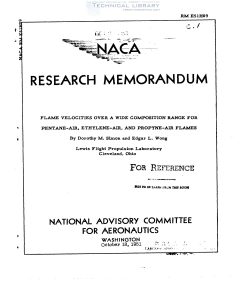naca-rm-e51h09
- Version
- 50 Downloads
- 1.67 MB File Size
- 1 File Count
- May 25, 2017 Create Date
- May 25, 2017 Last Updated
National Advisory Committee for Aeronautics, Research Memorandum - Flame Velocities Over a Wide Composition Range for Pentane-Air, Ethylene-Air, and Propyne-Air Flames

The change in flame velocity with fuel concentration in air was
investigated in order to determine whether an active particle diffusion
mechanism of flame propagation is consistent with the observed velocity
changes, and to Show whether the simplified diffusion mechanism as
expressed by the Tanford and Pease equation is sufficiently exact to
predict the velocity change with fuel concentration in air. Spatial
flame velocities were measured for nearly the total flammability range
for pentane-air, ethylene-air, and propyne-air mixtures by a modified
tube method at atmospheric pressure and 250 C. Flame shape as revealed
by direct photographs was studied. Flame front areas were measured from
the direct photographs for different fuel concentrations in air. Funda-
mental flame velocities were calculated for .the concentration range from
60 to 130 percent stoichiometric for the three hydrocarbons. Equilibrium
flame temperatures and equilibrium free radical concentrations were cal-
culated for pentane, ethylene, and propyn‘e over the total flammability
range in air. The velocity measurements together with these calculated.
concentrations were used for a quantitative evaluation of the active
particle diffusion theory. It is shown that a. general diffusion mecha-
nism is consistent with the observed changes in flame velocity with fuel
concentration, and that a form of the Tanford and Pease equation which
includes a flame velocity term independent of diffusion will predict the
velocity changes over a limited concentration range.
One of the important processes in a Jet-engine combustor is the
propagation of flame into the unburned. fueluair mixture. .A better under-
standing of the physical and chemical nature of this process may be
gained by a study of laminar flame speeds.
A research program is in progress at the NASA Lewis laboratory to
determine the effect of chemical structure on the maximum flame velocity
of fuel-air mixtures. The maximum flame velocities of all 52 hydro—
carbons studied are reported (references 1 and 2) to be consistent with
an active particle mechanism of flame propagation. It is also shown in
references 1 and 2 that the simplified active particle mechanism of
flame propagation as expressed by a modified equation of the type pro—
posed by Tanford and Pease (reference 3) could be used, with one specific
rate constant, to predict the maximum flame velocities for all of the
hydrocarbons except ethylene. In order to determine whether the change
in flame velocity with fuel concentration in air is also consistent with
an active particle diffusion mechanism of flame propagation and whether
the modified Tanford and Pease expression is sufficiently accurate to
predict this change, flame velocities must be known over a wide concen-
tration range.
| File | Action |
|---|---|
| naca-rm-e51h09 Flame Velocities Over a Wide Composition Range for Pentane-Air, Ethylene-Air, and Propyne-Air Flames.pdf | Download |

Comment On This Post